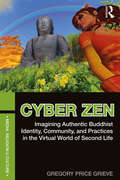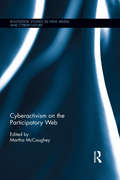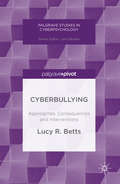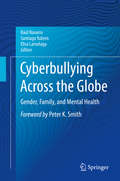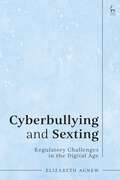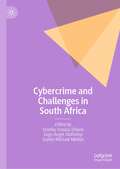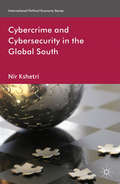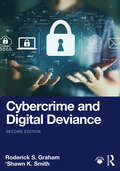- Table View
- List View
Cyber Zen: Imagining Authentic Buddhist Identity, Community, and Practices in the Virtual World of Second Life (Media, Religion and Culture)
by Gregory Price GrieveCyber Zen ethnographically explores Buddhist practices in the online virtual world of Second Life. Does typing at a keyboard and moving avatars around the screen, however, count as real Buddhism? If authentic practices must mimic the actual world, then Second Life Buddhism does not. In fact, a critical investigation reveals that online Buddhist practices have at best only a family resemblance to canonical Asian traditions and owe much of their methods to the late twentieth-century field of cybernetics. If, however, they are judged existentially, by how they enable users to respond to the suffering generated by living in a highly mediated consumer society, then Second Life Buddhism consists of authentic spiritual practices. Cyber Zen explores how Second Life Buddhist enthusiasts form communities, identities, locations, and practices that are both products of and authentic responses to contemporary Network Consumer Society. Gregory Price Grieve illustrates that to some extent all religion has always been virtual and gives a glimpse of possible future alternative forms of religion.
Cyberactivism: Online Activism in Theory and Practice
by Martha Mccaughey Michael D. AyersCyberactivism is a timely collection of essays examining the growing importance of online activism. The contributors show how online activists have not only incorporated recent technology as a tool for change, but also how they have changed the meaning of activism, what community means, and how they conceive of collective identity and democratic change. Topics addressed range from the Zapatista movement's use of the web to promote their cause globally to the establishment of alternative media sources like indymedia.org to the direct action of "hacktivists" who disrupt commercial computer networks. Cyberactivism is essential reading for anyone interested in understanding the impact of the Internet on politics today.
Cyberactivism: Online Activism in Theory and Practice (Routledge Studies In New Media And Cyberculture Ser.)
by Martha McCaughey Michael D. AyersCyberactivism is a timely collection of essays examining the growing importance of online activism. The contributors show how online activists have not only incorporated recent technology as a tool for change, but also how they have changed the meaning of activism, what community means, and how they conceive of collective identity and democratic change. Topics addressed range from the Zapatista movement's use of the web to promote their cause globally to the establishment of alternative media sources like indymedia.org to the direct action of "hacktivists" who disrupt commercial computer networks. Cyberactivism is essential reading for anyone interested in understanding the impact of the Internet on politics today.
Cyberactivism and Citizen Journalism in Egypt: Digital Dissidence and Political Change (Information Technology and Global Governance)
by Courtney C. RadschThis compelling book explores how Egyptian bloggers used citizen journalism and cyberactivism to chip away at the state’s monopoly on information and recalibrate the power dynamics between an authoritarian regime and its citizens. When the Arab uprisings broke out in early 2011 and ousted entrenched leaders across the region, social media and the Internet were widely credited with playing a role, particularly when the Egyptian government shut down the Internet and mobile phone networks in an attempt to stave off the unrest there. But what these reports missed were the years of grassroots organizing, digital activism, and political awareness-raising that laid the groundwork for this revolutionary change. Radsch argues that Egyptian bloggers created new social movements using blogging and social media, often at significant personal risk, so that less than a decade after the information revolution came to Egypt they successfully mobilized the overthrow of the state and its president.
Cyberactivism on the Participatory Web (Routledge Studies in New Media and Cyberculture)
by Martha McCaugheyCyberactivism already has a rich history, but over the past decade the participatory web—with its de-centralized information/media sharing, portability, storage capacity, and user-generated content—has reshaped political and social change. Cyberactivism on the Participatory Web examines the impact of these new technologies on political organizing and protest across the political spectrum, from the Arab Spring to artists to far-right groups. Linking new information and communication technologies to possibilities for solidarity and action—as well as surveillance and control—in a context of global capital flow, war, and environmental crisis, the contributors to this volume provide nuanced analyses of the dramatic transformations in media, citizenship, and social movements taking place today.
Cyberactivism on the Participatory Web (Routledge Studies in New Media and Cyberculture)
by Martha McCaugheyCyberactivism already has a rich history, but over the past decade the participatory web—with its de-centralized information/media sharing, portability, storage capacity, and user-generated content—has reshaped political and social change. Cyberactivism on the Participatory Web examines the impact of these new technologies on political organizing and protest across the political spectrum, from the Arab Spring to artists to far-right groups. Linking new information and communication technologies to possibilities for solidarity and action—as well as surveillance and control—in a context of global capital flow, war, and environmental crisis, the contributors to this volume provide nuanced analyses of the dramatic transformations in media, citizenship, and social movements taking place today.
Cyberbullies, Cyberactivists, Cyberpredators: Film, TV, and Internet Stereotypes
by Lauren RosewarneWritten by an expert in media, popular culture, gender, and sexuality, this book surveys the common archetypes of Internet users—from geeks, nerds, and gamers to hackers, scammers, and predators—and assesses what these stereotypes reveal about our culture's attitudes regarding gender, technology, intimacy, and identity.The Internet has enabled an exponentially larger number of people—individuals who are members of numerous and vastly different subgroups—to be exposed to one other. As a result, instead of the simple "jocks versus geeks" paradigm of previous eras, our society now has more detailed stereotypes of the undesirable, the under-the-radar, and the ostracized: cyberpervs, neckbeards, goths, tech nerds, and anyone with a non-heterosexual identity. Each chapter of this book explores a different stereotype of the Internet user, with key themes—such as gender, technophobia, and sexuality—explored with regard to that specific characterization of online users.Author Lauren Rosewarne, PhD, supplies a highly interdisciplinary perspective that draws on research and theories from a range of fields—psychology, sociology, and communications studies as well as feminist theory, film theory, political science, and philosophy—to analyze what these stereotypes mean in the context of broader social and cultural issues. From cyberbullies to chronically masturbating porn addicts to desperate online-daters, readers will see the paradox in popular culture's message: that while Internet use is universal, actual Internet users are somehow subpar—less desirable, less cool, less friendly—than everybody else.
Cyberbullies, Cyberactivists, Cyberpredators: Film, TV, and Internet Stereotypes
by Lauren RosewarneWritten by an expert in media, popular culture, gender, and sexuality, this book surveys the common archetypes of Internet users—from geeks, nerds, and gamers to hackers, scammers, and predators—and assesses what these stereotypes reveal about our culture's attitudes regarding gender, technology, intimacy, and identity.The Internet has enabled an exponentially larger number of people—individuals who are members of numerous and vastly different subgroups—to be exposed to one other. As a result, instead of the simple "jocks versus geeks" paradigm of previous eras, our society now has more detailed stereotypes of the undesirable, the under-the-radar, and the ostracized: cyberpervs, neckbeards, goths, tech nerds, and anyone with a non-heterosexual identity. Each chapter of this book explores a different stereotype of the Internet user, with key themes—such as gender, technophobia, and sexuality—explored with regard to that specific characterization of online users.Author Lauren Rosewarne, PhD, supplies a highly interdisciplinary perspective that draws on research and theories from a range of fields—psychology, sociology, and communications studies as well as feminist theory, film theory, political science, and philosophy—to analyze what these stereotypes mean in the context of broader social and cultural issues. From cyberbullies to chronically masturbating porn addicts to desperate online-daters, readers will see the paradox in popular culture's message: that while Internet use is universal, actual Internet users are somehow subpar—less desirable, less cool, less friendly—than everybody else.
Cyberbullying: Approaches, Consequences and Interventions (Palgrave Studies in Cyberpsychology)
by Lucy R. BettsDrawing on research evidence and media coverage, this book explores a number of key debates surrounding cyberbullying. The increasing digitization of society affords many benefits; however, some of these benefits are offset by more adverse consequences. Cyberbullying represents one of the adverse consequences of technology use, which has become a topic of increasing societal concern. Betts adopts a critical stance to exploring issues around the definition of cyberbullying, the unique nature of cyberbullying compared to other forms of bullying, the variation in the reported prevalence rates of cyberbullying, the consequences of involvement in cyberbullying, and the steps that can be taken to tackle cyberbullying.
Cyberbullying Across the Globe: Gender, Family, and Mental Health
by Raúl Navarro Santiago Yubero Elisa LarrañagaThis book provides a much-needed analysis of the current research in the global epidemic of electronic bullying. Scholars and professionals from the Americas, Europe, and Asia offer data, insights, and solutions, acknowledging both the social psychology and technological contexts underlying cyberbullying phenomena. Contributors address questions that are just beginning to emerge as well as longstanding issues concerning family and gender dynamics, and provide evidence-based prevention and intervention strategies for school and home. The global nature of the book reflects not only the scope and severity of cyberbullying, but also the tenacity of efforts to control and eradicate the problem. Included in the coverage: • Gender issues and cyberbullying in children and adolescents: from gender differences to gender identity measures. • Family relationships and cyberbullying.• Examining the incremental impact of cyberbullying on outcomes over and above traditional bullying in North America.• A review of cyberbullying and education issues in Latin America.• Cyberbullying prevention from child and youth literature.• Cyberbullying and restorative justice. Cyberbullying across the Globe is an essential resource for researchers, graduate students, and other professionals in child and school psychology, public health, social work and counseling, educational policy, and family advocacy.
Cyberbullying and Sexting: Regulatory Challenges in the Digital Age
by Dr Elizabeth AgnewDrawing on two empirical studies and influential theoretical frameworks, this book provides a critical overview of the key regulatory challenges concerning cyberbullying and sexting behaviours among young people (persons under 18 years).The author explores issues such as conceptualising the behaviours, examining the prevailing presence of sexism, myths and stereotypes surrounding gender roles and identity, and the limitations of criminal law as an effective regulatory tool. In doing so, identifying peer-based sexting behaviours as part of a continuum of sexual behaviour is promoted alongside the need to consider interventions beyond the legal landscape and in line with the United Nations Convention on the Rights of the Child. In the main, priority is given to non-legal responses and the need for more effective and comprehensive gender-sensitive education programmes. The book therefore provides a more developed conceptual understanding of sexting and cyberbullying behaviours among young people.
Cyberbullying and Sexting: Regulatory Challenges in the Digital Age
by Dr Elizabeth AgnewDrawing on two empirical studies and influential theoretical frameworks, this book provides a critical overview of the key regulatory challenges concerning cyberbullying and sexting behaviours among young people (persons under 18 years).The author explores issues such as conceptualising the behaviours, examining the prevailing presence of sexism, myths and stereotypes surrounding gender roles and identity, and the limitations of criminal law as an effective regulatory tool. In doing so, identifying peer-based sexting behaviours as part of a continuum of sexual behaviour is promoted alongside the need to consider interventions beyond the legal landscape and in line with the United Nations Convention on the Rights of the Child. In the main, priority is given to non-legal responses and the need for more effective and comprehensive gender-sensitive education programmes. The book therefore provides a more developed conceptual understanding of sexting and cyberbullying behaviours among young people.
Cybercomplexity: A Macroscopic View of Cybersecurity Risk (Advanced Sciences and Technologies for Security Applications)
by Carl S. YoungThis book tackles the problem of complexity within IT environments, i.e., "Cybercomplexity," which is generally recognized as a principal source of cybersecurity risk. The book first defines complexity and simplifies its analysis by assuming a probabilistic approach to security risk management. It then proposes a simple model of cybercomplexity that is based on Shannon entropy, a basic concept in information theory. The key drivers of cybercomplexity emerge from this model, where these drivers reveal the scale-dependence of cybersecurity risk and explain why macroscopic security controls are required to address cybersecurity risk on an enterprise scale. The significant operational implications of cybercomplexity are also discussed, thereby providing both a theoretical framework and a practical guide to addressing this longstanding problem in cybersecurity risk management.
Cybercrime: Criminal Threats from Cyberspace (Crime, Media, and Popular Culture)
by Susan W. BrennerThis fascinating and timely book traces the emergence and evolution of cybercrime as an increasingly intransigent threat to society.Cybercrime: Criminal Threats from Cyberspace is intended to explain two things: what cybercrime is and why the average citizen should care about it. To accomplish that task, the book offers an overview of cybercrime and an in-depth discussion of the legal and policy issues surrounding it. Enhancing her narrative with real-life stories, author Susan W. Brenner traces the rise of cybercrime from mainframe computer hacking in the 1950s to the organized, professional, and often transnational cybercrime that has become the norm in the 21st century. She explains the many different types of computer-facilitated crime, including identity theft, stalking, extortion, and the use of viruses and worms to damage computers, and outlines and analyzes the challenges cybercrime poses for law enforcement officers at the national and international levels. Finally, she considers the inherent tension between improving law enforcement's ability to pursue cybercriminals and protecting the privacy of U.S. citizens.
Cybercrime: Eine Einführung
by Edith HuberKaum eine andere Kriminalitätsart hat in den vergangenen Jahren einen derartig hohen Anstieg an Delikten und dementsprechende mediale Aufmerksamkeit erfahren wie die Cyber-Kriminalität, auch bekannt unter dem Begriff "Cybercrime". Ziel dieses Buches ist es, das Thema in all seinen Facetten darzustellen und nicht nur über die bekannten technischen und juristischen Beschreibungen. Dabei werden besonders auch die Verhaltensaspekte der Täter und Opfer aus kriminalsoziologischer und kriminalpsychologischer Sicht, der Modus Operandi, also der typische Tathergang, sowie die Ansätze einer Präventionsarbeit beschrieben. Der Fokus liegt auf der Entwicklung in Österreich, doch die Ergebnisse werden immer im Kontext des aktuellen internationalen Status reflektiert.
Cybercrime: Investigating High-Technology Computer Crime
by Robert MooreThis innovative text provides an excellent introduction to technology-assisted crime and the basics of investigating such crime, from the criminal justice perspective. It presents clear, concise explanations for students and professionals, who need not be technically proficient to find the material easy-to-understand and practical. The book begins by identifying and defining the most prevalent and emerging high-technology crimes — and exploring their history, their original methods of commission, and their current methods of commission. Then it delineates the requisite procedural issues associated with investigating technology-assisted crime. In addition, the text provides a basic introduction to computer forensics, explores legal issues in the admission of digital evidence, and then examines the future of high-technology crime, including legal responses.
Cybercrime: Investigating High-Technology Computer Crime
by Robert MooreThis innovative text provides an excellent introduction to technology-assisted crime and the basics of investigating such crime, from the criminal justice perspective. It presents clear, concise explanations for students and professionals, who need not be technically proficient to find the material easy-to-understand and practical. The book begins by identifying and defining the most prevalent and emerging high-technology crimes — and exploring their history, their original methods of commission, and their current methods of commission. Then it delineates the requisite procedural issues associated with investigating technology-assisted crime. In addition, the text provides a basic introduction to computer forensics, explores legal issues in the admission of digital evidence, and then examines the future of high-technology crime, including legal responses.
Cybercrime: The Transformation of Crime in the Information Age (Crime and Society)
by David S. WallHow has the digital revolution transformed criminal opportunities and behaviour? What is different about cybercrime compared with traditional criminal activity? What impact might cybercrime have on public security? In this updated edition of his authoritative and field-defining text, cybercrime expert David Wall carefully examines these and other important issues. Incorporating analysis of the latest technological advances and their criminological implications, he disentangles what is really known about cybercrime today. An ecosystem of specialists has emerged to facilitate cybercrime, reducing individual offenders’ level of risk and increasing the scale of crimes involved. This is a world where digital and networked technologies have effectively democratized crime by enabling almost anybody to carry out crimes that were previously the preserve of either traditional organized crime groups or a privileged coterie of powerful people. Against this background, the author scrutinizes the regulatory challenges that cybercrime poses for the criminal (and civil) justice processes, at both the national and the international levels. This book offers the most intellectually robust account of cybercrime currently available. It is suitable for use on courses across the social sciences, and in computer science, and will appeal to advanced undergraduate and graduate students.
Cybercrime and Challenges in South Africa
by Stanley Osezua Ehiane Sogo Angel Olofinbiyi Sazelo Michael MkhizeThe advent of the Internet for global advancement and development has opened the world to new crimes. This is the first comprehensive book on the subject matter, considering the absence of textbooks in teaching the subject matter in higher learning institutions. Hitherto, the book is distinctive and timely in the wake of the inclusion of the subject matter as a new curriculum in many African universities. The book focuses on South Africa, where the Internet has been misused by individuals to perpetuated crime which has been on the increase and unabated. The book's contents and its discourse are significant to students in higher institutions, researchers, and organizations, to give in-depth insights into varied cybercrime on various forms and the manners in which cybercrimes have been executed. Lastly, the book contains instances where the Internet has been used to perpetuate crimes in recent times in South Africa.
Cybercrime and Cybersecurity in the Global South (International Political Economy Series)
by N. KshetriIntegrating theories from a wide range of disciplines, Nir Kshetri compares the patterns, characteristics and processes of cybercrime activities in major regions and economies in the Global South such as China, India, the former Second World economies, Latin America and the Caribbean, Sub-Saharan Africa and Middle East and North Africa.
Cybercrime and Digital Deviance
by Roderick S. Graham 'Shawn K. SmithCybercrime and Digital Deviance is a work that combines insights from sociology, criminology, and computer science to explore cybercrimes such as hacking and romance scams, along with forms of cyberdeviance such as pornography addiction, trolling, and flaming. Other issues are explored including cybercrime investigations, organized cybercrime, the use of algorithms in policing, cybervictimization, and the theories used to explain cybercrime. Graham and Smith make a conceptual distinction between a terrestrial, physical environment and a single digital environment produced through networked computers. Conceptualizing the online space as a distinct environment for social interaction links this text with assumptions made in the fields of urban sociology or rural criminology. Students in sociology and criminology will have a familiar entry point for understanding what may appear to be a technologically complex course of study. The authors organize all forms of cybercrime and cyberdeviance by applying a typology developed by David Wall: cybertrespass, cyberdeception, cyberviolence, and cyberpornography. This typology is simple enough for students just beginning their inquiry into cybercrime. Because it is based on legal categories of trespassing, fraud, violent crimes against persons, and moral transgressions it provides a solid foundation for deeper study. Taken together, Graham and Smith’s application of a digital environment and Wall’s cybercrime typology makes this an ideal upper level text for students in sociology and criminal justice. It is also an ideal introductory text for students within the emerging disciplines of cybercrime and cybersecurity.
Cybercrime and Digital Deviance
by Roderick S. Graham 'Shawn K. SmithCybercrime and Digital Deviance is a work that combines insights from sociology, criminology, and computer science to explore cybercrimes such as hacking and romance scams, along with forms of cyberdeviance such as pornography addiction, trolling, and flaming. Other issues are explored including cybercrime investigations, organized cybercrime, the use of algorithms in policing, cybervictimization, and the theories used to explain cybercrime. Graham and Smith make a conceptual distinction between a terrestrial, physical environment and a single digital environment produced through networked computers. Conceptualizing the online space as a distinct environment for social interaction links this text with assumptions made in the fields of urban sociology or rural criminology. Students in sociology and criminology will have a familiar entry point for understanding what may appear to be a technologically complex course of study. The authors organize all forms of cybercrime and cyberdeviance by applying a typology developed by David Wall: cybertrespass, cyberdeception, cyberviolence, and cyberpornography. This typology is simple enough for students just beginning their inquiry into cybercrime. Because it is based on legal categories of trespassing, fraud, violent crimes against persons, and moral transgressions it provides a solid foundation for deeper study. Taken together, Graham and Smith’s application of a digital environment and Wall’s cybercrime typology makes this an ideal upper level text for students in sociology and criminal justice. It is also an ideal introductory text for students within the emerging disciplines of cybercrime and cybersecurity.
Cybercrime and Digital Deviance
by Roderick S. Graham 'Shawn K. SmithCybercrime and Digital Deviance, Second Edition, combines insights from sociology, criminology, psychology, and cybersecurity to explore cybercrimes such as hacking, identity theft, and romance scams, along with forms of digital deviance such as pornography addiction, trolling, and “canceling” people for perceived violations of norms.Other issues are explored including cybercrime investigations, nation-state cybercrime, the use of algorithms in policing, cybervictimization, and expanded discussion of the theories used to explain cybercrime. Graham and Smith conceptualize the online space as a distinct environment for social interaction, framing their work with assumptions informed by their respective work in urban sociology and spatial criminology, and offering an engaging entry point for understanding what may appear to be a technologically complex course of study. The authors apply a modified version of a typology developed by David Wall: cybertrespass, cyberfraud, cyberviolence, and cyberpornography. This typology is simple enough for students just beginning their inquiry into cybercrime, while its use of legal categories of trespassing, fraud, violent crimes against persons, and moral transgressions provides a solid foundation for deeper study. In this edition each chapter includes a new “Current Events and Critical Thinking” section, using concepts from the chapter to explore a specific event or topic like the effect of disinformation on social cohesion and politics.Taken together, Graham and Smith’s application of a digital environment and Wall’s cybercrime typology makes this an ideal upper-level text for students in sociology and criminal justice. It is also an ideal introductory text for students within the emerging disciplines of cybercrime and cybersecurity.
Cybercrime and Digital Deviance
by Roderick S. Graham 'Shawn K. SmithCybercrime and Digital Deviance, Second Edition, combines insights from sociology, criminology, psychology, and cybersecurity to explore cybercrimes such as hacking, identity theft, and romance scams, along with forms of digital deviance such as pornography addiction, trolling, and “canceling” people for perceived violations of norms.Other issues are explored including cybercrime investigations, nation-state cybercrime, the use of algorithms in policing, cybervictimization, and expanded discussion of the theories used to explain cybercrime. Graham and Smith conceptualize the online space as a distinct environment for social interaction, framing their work with assumptions informed by their respective work in urban sociology and spatial criminology, and offering an engaging entry point for understanding what may appear to be a technologically complex course of study. The authors apply a modified version of a typology developed by David Wall: cybertrespass, cyberfraud, cyberviolence, and cyberpornography. This typology is simple enough for students just beginning their inquiry into cybercrime, while its use of legal categories of trespassing, fraud, violent crimes against persons, and moral transgressions provides a solid foundation for deeper study. In this edition each chapter includes a new “Current Events and Critical Thinking” section, using concepts from the chapter to explore a specific event or topic like the effect of disinformation on social cohesion and politics.Taken together, Graham and Smith’s application of a digital environment and Wall’s cybercrime typology makes this an ideal upper-level text for students in sociology and criminal justice. It is also an ideal introductory text for students within the emerging disciplines of cybercrime and cybersecurity.
Cybercrime and Digital Forensics: An Introduction
by Thomas J. Holt Adam M. Bossler Kathryn C. Seigfried-SpellarThis book offers a comprehensive and integrative introduction to cybercrime. It provides an authoritative synthesis of the disparate literature on the various types of cybercrime, the global investigation and detection of cybercrime and the role of digital information, and the wider role of technology as a facilitator for social relationships between deviants and criminals. It includes coverage of: key theoretical and methodological perspectives; computer hacking and malicious software; digital piracy and intellectual theft; economic crime and online fraud; pornography and online sex crime; cyber-bullying and cyber-stalking; cyber-terrorism and extremism; digital forensic investigation and its legal context around the world; the law enforcement response to cybercrime transnationally; cybercrime policy and legislation across the globe. The new edition features two new chapters, the first looking at the law enforcement response to cybercrime and the second offering an extended discussion of online child pornography and sexual exploitation. This book includes lively and engaging features, such as discussion questions, boxed examples of unique events and key figures in offending, quotes from interviews with active offenders, and a full glossary of terms. This new edition includes QR codes throughout to connect directly with relevant websites. It is supplemented by a companion website that includes further exercises for students and instructor resources. This text is essential reading for courses on cybercrime, cyber-deviancy, digital forensics, cybercrime investigation, and the sociology of technology.
